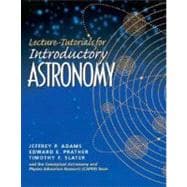
| The Night Sky | |
| Position | |
| Motion | |
| Seasonal Stars | |
| Solar vs. Sidereal Day | |
| Ecliptic | |
| Star Charts | |
| Fundamentals of Astronomy | |
| Keplerrsquo;s 2 nd Law | |
| Keplerrsquo;s 3 rd Law | |
| Newtonrsquo;s Laws and Gravity | |
| Apparent and Absolute Magnitudes of Stars | |
| The Parsec | |
| Parallax and Distance | |
| Spectroscopic Parallax | |
| Nature of Light in Astronomy | |
| The Electromagnetic (EM) Spectrum of Light | |
| Telescopes and Earthrsquo;s Atmosphere | |
| Luminosity, Temperature and Size | |
| Blackbody Radiation | |
| Types of Spectra | |
| Light and Atoms | |
| Analyzing Spectra | |
| Doppler Shift | |
| Our Solar System | |
| The Cause of Moon Phases | |
| Predicting Moon Phases | |
| Path of Sun | |
| Seasons | |
| Observing Retrograde Motion | |
| Earthrsquo;s Changing Surface | |
| Temperature and Formation of Our Solar System | |
| Sun Size | |
| Stars Galaxies and Beyond | |
| H-R Diagram | |
| Star Formation and Lifetimes | |
| Binary Stars | |
| The Motion of Extrasolar Planets | |
| Stellar Evolution | |
| Milky Way Scales | |
| Galaxy Classification | |
| Looking at Distant Objects | |
| Expansion of the Universe | |
| Table of Contents provided by Publisher. All Rights Reserved. |
The New copy of this book will include any supplemental materials advertised. Please check the title of the book to determine if it should include any access cards, study guides, lab manuals, CDs, etc.
The Used, Rental and eBook copies of this book are not guaranteed to include any supplemental materials. Typically, only the book itself is included. This is true even if the title states it includes any access cards, study guides, lab manuals, CDs, etc.